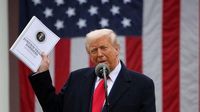On Wednesday, April 2, 2025, U.S. President Donald Trump made a significant announcement regarding new tariff measures, declaring the day as "Liberation Day" for the United States. During a nearly one-hour speech at the White House Rose Garden, Trump outlined his administration's plans to impose reciprocal tariffs on a wide range of countries, effectively reshaping U.S. trade policy.
Trump confirmed that a minimum tariff of 10% will be applied to all products imported into the United States. This measure is part of a broader strategy aimed at addressing what Trump described as unfair trade practices by other nations. In his words, many countries have imposed disproportionate tariffs on American imports, which he likened to "cheating." He stated, "We have to start taking care of our country now," emphasizing the need for a renewed focus on American manufacturing.
In addition to the blanket tariff, Trump announced a 25% tariff on automobiles produced outside the United States, which is set to take effect immediately. He explained that the U.S. would charge other countries "approximately half" of what they charge American products, noting that this would not be a fully reciprocal tariff system. "We could have done it, yes, but it would have been difficult for many countries," he added.
The announcement included a detailed list of countries that would face these new tariffs, with almost all of Latin America affected. Countries such as Argentina, Bolivia, Brazil, Chile, Colombia, and others will see the minimum 10% tariff applied. Exceptions include Nicaragua, which will face an 18% tariff, and Venezuela, which will incur a 15% tariff. Major trading partners, including China and the European Union, will face even steeper tariffs of 34% and 20%, respectively.
Interestingly, Mexico and Canada were notably excluded from this new tariff regime. The White House clarified that existing orders under the United States-Mexico-Canada Agreement (T-MEC) will remain in effect, meaning that products compliant with the agreement will continue to enjoy a 0% tariff. Non-compliant goods will face a 25% tariff, while energy products and potash that do not comply will incur a 10% tariff. This decision was welcomed by some experts, such as Gabriela Siller, director of Economic Analysis at Grupo Financiero BASE in Mexico, who pointed out that Mexico would benefit from lower tariffs compared to other economies affected by the new measures.
Trump's rhetoric during the announcement was assertive, as he characterized the new tariffs as a declaration of economic independence for the United States. "It's very simple, it couldn't be simpler; this is our declaration of economic independence," he stated. He expressed confidence that the implementation of these tariffs would lead to a revitalization of American manufacturing, envisioning new factories replacing those that are "empty" and "dying." Trump stated, "Totally new, the best in the world," indicating his belief in the potential for job creation and economic growth stemming from these policies.
The tariffs are set to take effect in two phases: the 10% tariffs will begin on April 5, 2025, while the higher rates will be implemented on April 9, 2025. This timeline reflects Trump's urgency in enacting these measures as part of his broader economic agenda.
While the announcement has been met with mixed reactions, it underscores a significant shift in U.S. trade policy under Trump's administration. Critics argue that such tariffs could lead to increased prices for consumers and strain relationships with key trading partners. However, supporters maintain that these measures are necessary to protect American jobs and industries from unfair foreign competition.
As the dust settles from this announcement, the implications of Trump's tariffs will likely reverberate across global markets. Economists and trade experts will be closely monitoring the effects on both domestic industries and international relations, particularly with those countries that are now facing increased tariffs.
In summary, Trump's new tariff measures represent a bold step towards reshaping U.S. trade dynamics, with significant implications for both American consumers and foreign nations. As the administration moves forward with these policies, the impact on the economy and international trade relationships will become increasingly apparent.






